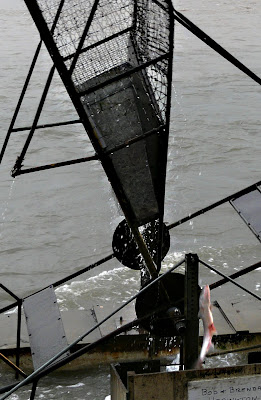
Arrival of these two cruise ships adds more than a third to Sitka's population.
Sitka's radio station began the morning news with the most important news first – just like a real radio station should. “Two cruise ships will arrive in Sitka this morning, Zaandam and Radiance of the Seas. They will bring 3,645 passengers ashore.” People with money were about to arrive. Get your sweatshirts and caps and Alaskan knives and Russian Orthodox gee-gaws out on the sidewalk. The tourists are coming. The tourists are coming.
We drove downtown on a beautiful Chelsea morning. Clouds wreathed the extinct volcano that is the backdrop to the town. But the sparkling sun showered the harbor with diamonds on the water. Delicious.
And in came the tourists. Sitka is too small to permit a cruise ship to dock. So the enormous ships parked out in Sitka Sound and ferried their passengers ashore. The difference between Tuesday and Monday in the little town was the difference between night and day. Sitka has 8,969 souls and was humming with activity. On Monday, we basically owned the town. We could park and walk at will.
We were able to visit St. Michael's Cathedral because the tourists were in. What opulence! Pretty much every wall was tarted up with silver and gold iconography. This is the former Russian capital of Russian America. The cathedral was consecrated in 1748. It was designed by Bishop Ivan Veniaminov who came here in 1834. This fellow truly was a renaissance man. Not only did he create a Russian-Aleut dictionary while working as a priest in the Aleutian Islands, he started another dictionary for the Tlingit aboriginals when he arrived here. He was a carpenter (constructed his own throne, plus lots of furniture in the Bishop's House which we visited on Monday). He also was a self-taught mathematician. Ninety percent of the congregation in the cathedral today is Tlingit.
The bishop was canonized as Saint Innocent in 1977.
On Monday, we'd visited the Bishop's house, a large but plain structure. It is the best preserved of four Russian structures in the western hemisphere. We then walked through the Sitka's National Historic Park where there is a collection of totem poles. Each tells a story about a Tlingit clan which was explained to us by using our cell phone. There is even a totem with a white man at the top. This totem story tells a story of thievery of shell fish and other goods. It was carved so the wrong could be righted. Was it? Doubtful.
Many of the stories of the poles dealt with the raven, which is considered the trickster who plays with men's lives. There are carving of whales, orcas, bears, frogs, as well as the topmost part which often shows a man in what looks like a top hat. They are actually the watchmen of the clans. The top hat get taller and taller as the watchman gains in stature.
We boarded Columbia for the next leg of our voyage south. Because this was an overnight leg, we got a berth so we could sleep in comfort. Some of our fellow passengers were much more rugged. They set up their tents on the rear deck, holding them down with duct tape.
We awoke in the middle of the night when we docked in Petersburg. Then we were off, through Wrangell Straits, arriving at 7:45 a.m. On time.
Jo was the first vehicle off, aboard the Honda Fit. I was not to lucky. I was the largest rig aboard and the crew had me back up about 50 yards with one inch to spare on each side of the rig. Just a little stressful!
We parked in a Tlingit-run campground to the south of the little town. Wrangell is too small to receive and handle cruise ships and, as a result, calls itself “the true Alaska.” Well, maybe. There were little kids on the waterfront, selling garnets they are allowed to chisel from the rock face across from the town.
The town has about 1,800 people– down from 2,550 in five years. “The young people leave here and never return,” one local woman told us when we visited the petroglyph beach. This is a place where 8,000-year-old petroglyphs (carvings in stone) are lying on the beach between high and low tide marks. They are thought to have been created by the people who came to Alaska before the Tlingit Indians.
Just north of the petroglyph beach is Dead Man's Island. Back in the 1800s, Chinese workers at the local salmon canning factory were taken there when they died. Their bodies were pickled in brine and placed in wooden casks before being shipped back for burial at home in China. All of this is described in great detail by James Michener in his must-read novel, “Alaska.”
In the evening, we drove and hiked to Nemo Point, south of town. We had the place to ourselves and the perfection of the peaceful scene left us breathless. We sat 2,000 feet above Zimovia Straits and watched the fishing boats shuttle back and forth in the sparkling waters below. There was not a sound to be heard at this height – not even a bird. Jo maintained a soft chatter – mostly to alert bears of our presence - but none appeared.
We managed to get into Chief Shake's House on the waterfront on Thursday morning. This is a Tlingit tribal house. The carvings inside were extraordinarily good (see photo album). Happily, Chief John, a Tlingit who also is of the Wolf clan, spoke with us about the traditions. He also showed us a traditional Tlingit canoe he himself had carved 15 years ago. Beautiful workmanship and lines to this little vessel.










